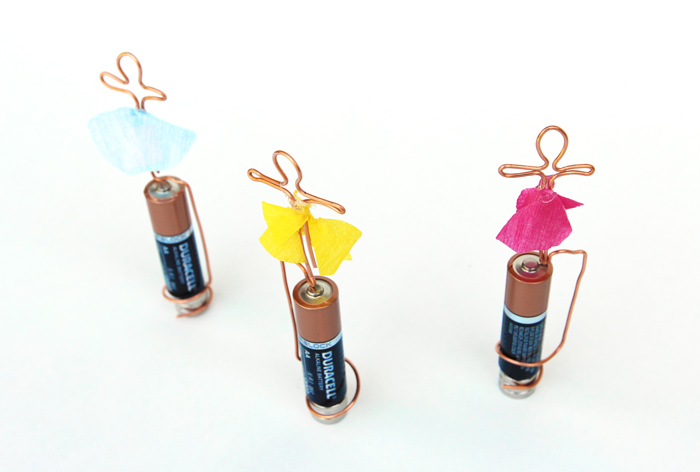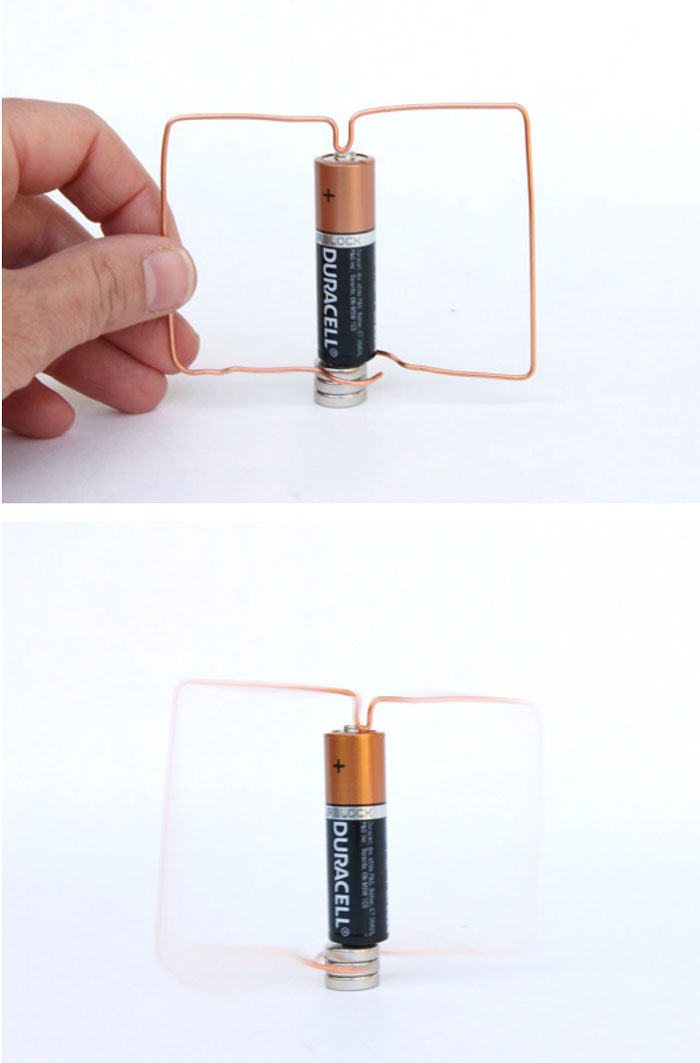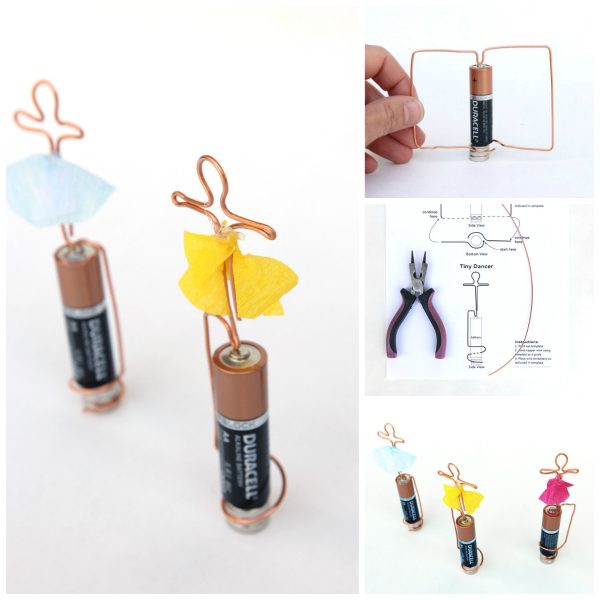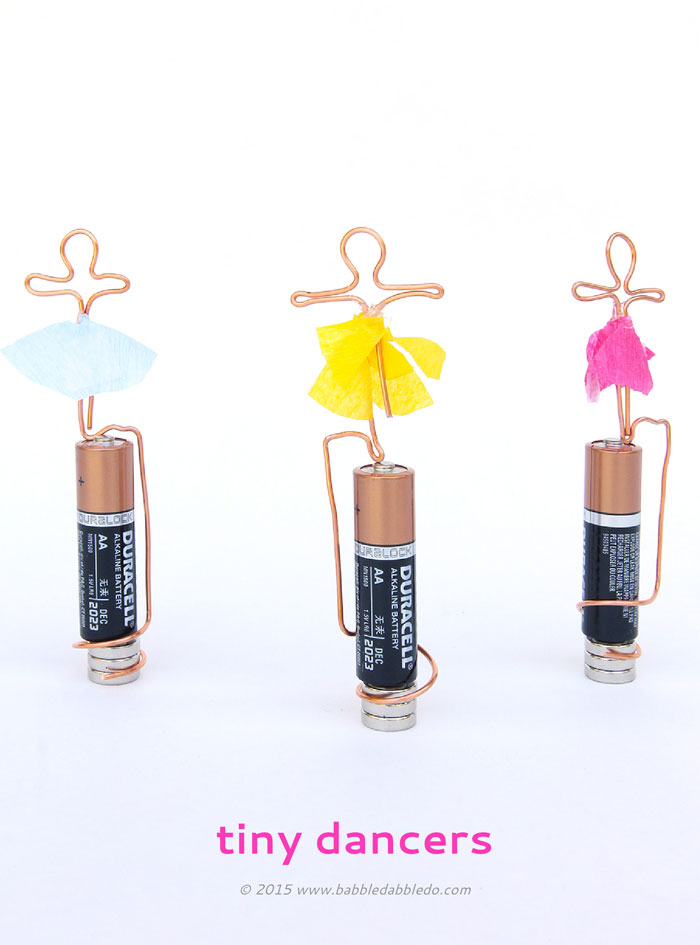Today we are getting a bit artsy with our science! Does the idea of making a wire sculpture that “dances” entice you……? Tiny Dancers is the third project in our collaborative series STEAM POWER: Empowering kids to explore the world through creative projects. Today’s topic is HARNESS!



Because harnessing refers to making use of resources to produce energy we decided to try making a homopolar motor. A homopolar motor is probably the simplest DIY motor you can make. You need just a few easy to obtain items and it’s FAIRLY simple to construct. Homopolar motors are not useful motors in anything but science experiments but they do demonstrate some interesting concepts and are fun to watch! They are also a great introduction to electricity and electromagnetism.
This post contains affiliate links to products I love and recommend to my readers.
SAFETY NOTE:
Neodymium magnets are extremely strong and MUST BE KEPT OUT OF REACH OF SMALL CHILDREN! Do not give them to any child who might put them in their mouth, they are dangerous if swallowed and must be surgically removed! This is a project for older children who can understand the precautions and I recommend ADULT SUPERVISION! For more about neodymium magnets safety and precautions go here Additionally neodymium magnets can interfere with electronic devices so please keep them away from phones!
Also please note that these motors do heat up. See our TIPS section for safety precautions.
Tiny Dancers (A Homopolar Motor)
Note: Before we get started I want you to know that despite this looking very easy there is a fair amount of TWEAK TIME you will need to invest to make this project work! I recommend starting with a BASIC HOMOPOLAR MTOR to get the hang of how the motor actually works, then trying your hand at making a tiny dancer. Each dancer will need to be tweaked to get them to dance properly on a battery. Don’t be discouraged if at first it doesn’t work, keep tweaking and see our tips sections for some troubleshooting solutions.
Materials
 download our template here
download our template here
- Copper Wire- THIS is the gauge we used
- 1/2″ x 1/8″ Neodymium Disc Magnets
- AA Battery
- 3 in 1 Combination Tool
or pliers/wire cutters
- Template
- Crepe Paper (optional for skirt)
- Hot Glue (optional)
Instructions
- Steps One Cut a long piece of wire off your spool, I started with about a 10” long piece. Lay it on the template of your choice and bend as shown using 3-in 1 tool or pliers. No need to be perfect HOWEVER try and keep your form as symmetrical as possible.
- Step Two To create the base section of wire that wraps the magnets, I recommend bending the end of the wire around the battery. Remove the battery and gently widen the circular wire form with your fingers.
- Step Three Place three neodymium magnets on the negative side of your battery.
- Step Four Place the motor on top of the battery so that it touches the positive pole. The round section at the bottom of the motor must be low enough to encircle the magnets!
- Step Five Let it go. If properly constructed it should start to spin. If it doesn’t see our tips below.
- Step Six (optional) to make a skirt for your dancer cut a small circle of crepe then cut a slit in the center of the circle. Slide it up onto the dancer and secure in place with a dab of hot glue.

Tips
- MONITOR THESE FOR HEAT! Some of the motors that got going really fast heated up quite quickly. If you notice a battery getting usually warm stop the project, let it cool down and remove the magnets. I recommend against reusing a battery that got overheated. Instead replace it with a fresh battery. One educator warned me about a defective battery that peeled open during this experiment. Please monitor the motors closely as they spin.
- Start with your basic homopolar motor. It’s easy to bend and shape and you should have success with it. The dancers require more time to fine tune.
- Keep the forms as symmetrical as possible! Since they spin on an axis if the are not symmetrical and/or balanced they will spin off the battery! This happened to us all.the.time. If they do spin off try and bend the form slightly to get them balanced on the battery.
- To make the head of the dancer, bend your wire around a pencil.
- Thin wire does not work! We tried this with very thin copper wire at first and it did not work. Stick to heavier gauges. Here is the gauge we used.
- The templates are meant as GUIDES ONLY! The motors will need to be fine tuned by hand by you!
- Remove the magnets immediately after running your motor. They will drain your motor if kept attached.
- When the electrical circuit is completed you will hear a very low buzz.
Troubleshooting
- If the motor does not work try turning your magnets upside down and reversing the polarity. I found this did the trick most of the time.
- The batteries burn out quickly! If turning the magnets upside down doesn’t work, try replacing your battery with a new one.
- Make sure that the bottom section of wire encircles the magnets. If it doesn’t your motor will not work.
- Be sure your wire is free to move around the battery and magnets. If it’s too close to the battery or magnet it will get stuck and be motionless.
- I read that you can use a nail to put a small indentation in the top of your battery to help keep the motor in place. I highly recommend AGAINST doing this. I tried it! One small and light dent worked and the next dent smashed a hole in the battery causing battery acid to spin on my counter! Eek! I decided off balance motors were better than battery acid splashes.

What’s happening?
I’m going to keep this as simple as possible because let’s face it, electromagnetism is hard to explain! Basically homopolar motors demonstrate something called a Lorentz Force. This is a force that is generated when electricity moves through a magnetic field. Our copper wire is conducting electricity from one end of the battery to the other. As it moves through the magnets on the negative side of the battery, it creates a force which causes the wire to spin.
You can read more about the Lorentz force and homopolar motors here and here.
Looks Like
Hendrik Lorentz. Hendrik Lorentz was a Nobel Prize winning Dutch physicist who inspired Albert Einstein! The Lorentz Force is named after him though he was not the first to discover its existence. In his early years Lorentz was primarily interested in studying electromagnetism and light. Albert Einstein used Lorentz’s paper “On the Electrodynamics of Moving Bodies “ as the basis of his own work and the theory of special relativity. It’s super complex stuff but suffice it to say Lorentz ‘s studies of electromagnetism laid the groundwork for some of the most important scientific discoveries of the last century.

Ready for more projects that harness energy?
My fellow bloggers have done a wide variety of projects you have to check out!
Simple Circuit – What Do We Do All Day
Rubber Band Car – All for the Boys
Lego Inspired Electric Dough – Lemon Lime Adventures
Design Thinking – Meri Cherry
Mason Jar Solar Night Lights – Tinkerlab
Electromagnetic Train – Frugal Fun For Boys
10 Ways to Play & Learn with Springs – Left Brain Craft Brain
If you are looking to incorporate more STEAM ideas into your family’s creative day check out our STEAM Kids Book
Fill your child’s life with more art, design, science, and engineering!
Subscribe and get our projects delivered straight to your inbox.

 download our template here
download our template here
Well…. that is pure awesomeness!
Thanks Mama!
cool
ok, i am in 5th grade and I’m doing the tiny dancers for my science project. THIS IS SO COOL!
woo hoo!
Love the combo of adorable dancers and battery power! My daughter just gave the highest compliment: “I want to do that! Now!”
You just blew me away.
These are adorable, Ana. Just adorable!
I love the simplicity of this (and yet, it seems quite complicated). Brilliant, Ana.
Thank you so much Rachelle!
This is AMAZING. I cannot wait to try this with my STEM-obsessed little dancers. Thank you so much for sharing. The video was incredible, too, by the way! Nicely done!!
Thank you so much Cait!
What a great idea!
Thanks Mariana!
These are so cool! 🙂 Love how they look like they’re dancing!
Thanks Leslie!
I see you have a link for the magnets, but do you have any ideas of where I might be able to find them locally? (Or type of store that might carry them?)
Thanks for the great idea! My kids can’t wait to do this activity!
Possibly Radio Shack or an electronics store but they usually stock only ceramic magents which are not strong enough. Call ahead and see!
Do you think ferrite magnets might work? I am having a hard time paying $20 for neodymium magnets!
Hi Sallie,
I’m not sure but magus is they will not work. They just don’t have the power of neodymium.
Planning a ballerina-themed birthday for my oldest this summer… these will make the cutest centerpieces. Do you think they would work with a bigger battery too?
They are pretty finicky so I’d stick with the small battery. Plus these babies get got after spinning awhile so take precautions if experimenting with a larger battery 🙂
What guage wire did you use?
16 Gauge. Here’s the product we used: http://amzn.to/1BJcthJ
Sorry to keep pestering–that link is broken too! I’m not sure where to buy the battery?
No prob! Here is a link 🙂 http://amzn.to/1S6bawG
The link to buy the magnets is broken. Could you tell me which size I should order off Amazon.
Thanks for letting me know! Here is the link : http://amzn.to/1CqrBeF
This is not working for us. I tried all of your troubleshooting tips but no luck. Any ideas?
Sorry I’m just seeing this Shannon! Did you get it to work? I’m happy to help you troubleshoot if you still need it. Email me at anadziengel@gmail.com.
What size are the magnets that you used? I am figuring out that they are not easy to find. Thanks!
1/2″ diameter x 1/8″ thick. They are best ordered online 🙂
How long approximately would an AA battery last if they dance non-stop?
I’m not sure. Ours burnt out after a day or two of use but we didn’t have them running non stop. I probably wouldn’t leave them running indefinitely as the battery gets hot. They should be run with supervision.
Can you put another link to the magnets? The link is no longer working. Thank you
Thanks for letting me know! The link has been updated 🙂
deneyi yapıyordum ama sizinki daha güzel. Teşekkür.
Can you use Bare Copper 16 Gauge Artistic wire?
I believe that should work 🙂
Awesome article!! The magnets are available at all Michael’s craft stores, and I believe A.C. Moore also carries them. Cool!!
Good to know!Thanks!
This project was done at my school and me and my class mates loved it
I love hearing this Lena!!! It makes my day!
I absolutely love this science project idea. The fact that it is tailored to little girls I think makes it more attractive for them. These type of projects can often be more of boy interest. Keep it up!
Thank you so much for the encouraging words!
Brilliant!
Do you have to use that size disc battery or can you use a little bigger one? The next size up is all I can find on amazon. The link posted for the magnets, is not secure for credit card. My pop up security feature came up when I tried to order there. 🙂
what age group do you think this is for? my daughter in middle school and is doing this for her school.
Thanks for this article. You wrote that “If the motor does not work try turning your magnets upside down and reversing the polarity.” But this only reverse the motion of wire, it does not affect working.
Awesome job with batteries. That looks great. Thanks for your idea
Thank you for this! Is there a way this project can be done for a class of students at a lower cost? IE: Would smaller batteries/magnets/wire have the same effect?
Awwwwww!!!! Great idea! Thank you. Bloggi
Thank you!
We had a big problem doing this activity. I used supplies [magnets, wire] from the sources you cited and duracell batteries. I first had the students shape the wire and then gave out the batteries, waiting to put the magnets in place only at the very end. After about 2-3 minutes more than one pair of students noticed the batteries getting warm, one very much so–and that battery actually peeled open and we had to shut down the activity!
I think it was a defect with the battery, but I thought I should highlight this for other users/educators so that they know that the batteries need extreme caution and that in general this is an experiment with a high degree of caution
Hi Veronica,
Thank you for sharing your experience. I do have a warning in the post that these heat up and I appreciate you bringing it up again in your comment. I did this project many times without an issue of a battery peeling open though some batteries did get warm over time. I will add an additional note about your concern.
Thank you,
Ana
Put a small nut on top of the battery and the dancer will stay centered. I lost my patience with trying to tweak it!
Thanks for the tip!
We are doing this project for my son’s science fair. The hardest thing was finding the magnets we found a good deal on ebay. And instead of tiny dancers we are doing rockets and airplanes. Let’s see how bit goes. Thanks for the step by step video
Rockets and airplanes sounds great! I hope it was a success!
Amazing post Ana!!! I appreciate your talent. Here you described step by step procedure. I really love the dancers and the battery power. Keep up…
At first, I was like this is the perfect project for STEM , I’m going to do this… Then when it said all the negative and dangerous things about the battery I’m still confused should I do it or not?
It’s great for older kids. Anyone that tries it should be aware of the potential safety concerns which is why I have added the Safety Notes.
Thank you for sharing, we have not yet success in getting it work….
I’m sorry to hear that Koko. Have you checked out our troubleshooting section?
I need photos of the steps, but i don´t know in were can i found it!!!
Anyway thanks
for the experiment!!
Hi Rafaella,
What steps are you looking for images for?
Ana
What a great idea! This is awesome! Thanks for sharing this creativity. Amazing post!
Yay! Glad you liked it!
Hello!
I love your ideas here and I wanted to use one of your activities for a school assignment, how would I be able to reference you in APA format?
Thank you!
What is APA format?